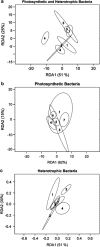Stochastic and deterministic processes interact in the assembly of desert microbial communities on a global scale
- PMID: 21368908
- PMCID: PMC3160679
- DOI: 10.1038/ismej.2011.21
Stochastic and deterministic processes interact in the assembly of desert microbial communities on a global scale
Abstract
Extreme arid regions in the worlds' major deserts are typified by quartz pavement terrain. Cryptic hypolithic communities colonize the ventral surface of quartz rocks and this habitat is characterized by a relative lack of environmental and trophic complexity. Combined with readily identifiable major environmental stressors this provides a tractable model system for determining the relative role of stochastic and deterministic drivers in community assembly. Through analyzing an original, worldwide data set of 16S rRNA-gene defined bacterial communities from the most extreme deserts on the Earth, we show that functional assemblages within the communities were subject to different assembly influences. Null models applied to the photosynthetic assemblage revealed that stochastic processes exerted most effect on the assemblage, although the level of community dissimilarity varied between continents in a manner not always consistent with neutral models. The heterotrophic assemblages displayed signatures of niche processes across four continents, whereas in other cases they conformed to neutral predictions. Importantly, for continents where neutrality was either rejected or accepted, assembly drivers differed between the two functional groups. This study demonstrates that multi-trophic microbial systems may not be fully described by a single set of niche or neutral assembly rules and that stochasticity is likely a major determinant of such systems, with significant variation in the influence of these determinants on a global scale.
Figures



Similar articles
-
Distinct microbial communities under different rock-associated microhabitats in the Qaidam Desert.Environ Res. 2024 Jun 1;250:118462. doi: 10.1016/j.envres.2024.118462. Epub 2024 Feb 15. Environ Res. 2024. PMID: 38367835
-
Highly specialized microbial diversity in hyper-arid polar desert.Proc Natl Acad Sci U S A. 2009 Nov 24;106(47):19964-9. doi: 10.1073/pnas.0908274106. Epub 2009 Oct 22. Proc Natl Acad Sci U S A. 2009. PMID: 19850879 Free PMC article.
-
Evidence of species recruitment and development of hot desert hypolithic communities.Environ Microbiol Rep. 2013 Apr;5(2):219-24. doi: 10.1111/1758-2229.12003. Epub 2012 Oct 28. Environ Microbiol Rep. 2013. PMID: 23584965
-
Hypolithic microbial communities: between a rock and a hard place.Environ Microbiol. 2012 Sep;14(9):2272-82. doi: 10.1111/j.1462-2920.2012.02821.x. Epub 2012 Jul 11. Environ Microbiol. 2012. PMID: 22779750 Review.
-
Microbial ecology of hot desert edaphic systems.FEMS Microbiol Rev. 2015 Mar;39(2):203-21. doi: 10.1093/femsre/fuu011. Epub 2015 Jan 23. FEMS Microbiol Rev. 2015. PMID: 25725013 Review.
Cited by
-
Turnover in Life-Strategies Recapitulates Marine Microbial Succession Colonizing Model Particles.Front Microbiol. 2022 Jun 23;13:812116. doi: 10.3389/fmicb.2022.812116. eCollection 2022. Front Microbiol. 2022. PMID: 35814698 Free PMC article.
-
Global Diversity of Desert Hypolithic Cyanobacteria.Front Microbiol. 2017 May 16;8:867. doi: 10.3389/fmicb.2017.00867. eCollection 2017. Front Microbiol. 2017. PMID: 28559886 Free PMC article.
-
Spatial patterns of hypolithic cyanobacterial diversity in Northern Australia.Ecol Evol. 2017 Jul 31;7(17):7023-7033. doi: 10.1002/ece3.3248. eCollection 2017 Sep. Ecol Evol. 2017. PMID: 28904780 Free PMC article.
-
Stochastic and Deterministic Effects of a Moisture Gradient on Soil Microbial Communities in the McMurdo Dry Valleys of Antarctica.Front Microbiol. 2018 Nov 1;9:2619. doi: 10.3389/fmicb.2018.02619. eCollection 2018. Front Microbiol. 2018. PMID: 30450087 Free PMC article.
-
Bacterioplankton Assembly Along a Eutrophication Gradient Is Mainly Structured by Environmental Filtering, Including Indirect Effects of Phytoplankton Composition.Microb Ecol. 2023 Feb;85(2):400-410. doi: 10.1007/s00248-022-01994-x. Epub 2022 Mar 19. Microb Ecol. 2023. PMID: 35306576
References
-
- Abdo Z, Schuette UME, Bent SJ, Williams CJ, Forney LJ, Joyce P. Statistical method for characterizing diversity of microbial communities by analysis of terminal restriction fragment length polymorphisms of 16S rRNA genes. Environ Microbiol. 2006;8:929–938. - PubMed
-
- Bell G. The distribution of abundance in neutral communities. Am Nat. 2000;155:606–617. - PubMed
-
- Bell T. Experimental tests of the bacterial distance–decay relationship. ISME J. 2010;4:1357–1365. - PubMed
-
- Bell T, Newman JA, Silverman BW, Turner SL, Lilley AK. The contribution of species richness and composition to bacterial services. Nature. 2005;436:1157–1160. - PubMed

